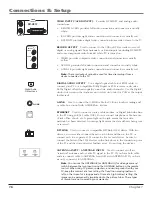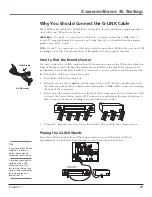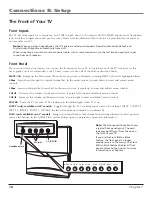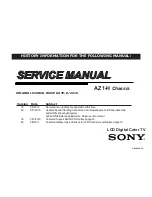
Connections & Setup
12
Chapter 1
ETHERNET
VIDEO
INPUT 5
DVI-HDTV
Explanation of Input Jacks and Cables
This section describes the jacks and cables you might use to make connections (cables may be ordered separately by using
the order form on page 75). There are several ways to connect components to your TV.
Different jacks and cables provide a different level of performance. It’s important to remember the different degrees of
picture improvement for comparison. If you use the DVI-HDTV and DTV LINK, the picture improvement can be noticeable
depending on the source material. The component jacks are considered an excellent improvement; S-Video and composite
jacks are considered very good while the antenna RF connection is good.
DVI-HDTV (Digital Visual Interface-High Definition Television) Connector
DVI-HDTV is an uncompressed, digital video interface designed to deliver
digital video in its native format. It supports the overlay of high-resolution
graphics used by some program guides and interactive devices. The signal
speed through a DVI-HDTV interface reaches 1.78 gigabits per second with
high-definition video. Audio information is carried separately
Note:
Remember to connect the left and right audio cables because the
S-Video cable carries only the picture signal, not the sound.
DTVLink® (Digital Television Link) Connectors
DTVLink is a compressed digital video input offering an IEEE-1394 type video
connection from consumer devices such as satellite receivers, cable receivers,
and digital recorders that meet the CEA specifications for DTVLink. DTVLink is
better known to some as 1394 or FireWire for digital televisions. If your 1394
device has the DTVLink logo on it, it should work with this TV. Audio and
video information is carried on a single wire. You can use either or both
connectors to link your devices.
Ethernet Jack and Cable
This jack is used to connect a router, cable modem or DSL (Digital Subscriber
Line) unit.
Digital Audio Out Jack and Optical Cable
The optical cable is used to connect a Dolby Digital or PCM receiver to your
TV. If you own a Dolby Digital or PCM receiver that uses an optical cable input,
you can use an optical cable to connect the TV to that receiver for the best
sound quality.
Note:
This TV’s optical digital output jack fully complies with the
international standard governing this type of jack (IEC958), and is
designed for connection to a Dolby Digital (AC-3
®
or PCM) receiver or
Dolby Digital (AC-3 or PCM) decoder. Older equipment, some of which is
not fully compliant with IEC958, may not be compatible with the Dolby
Digital bitstream. Such a connection using anything other than Dolby
Digital (AC-3 or PCM) receiver or decoder could create a high noise level,
causing damage to headphones or speakers.
Digital Audio
Output Jack















































